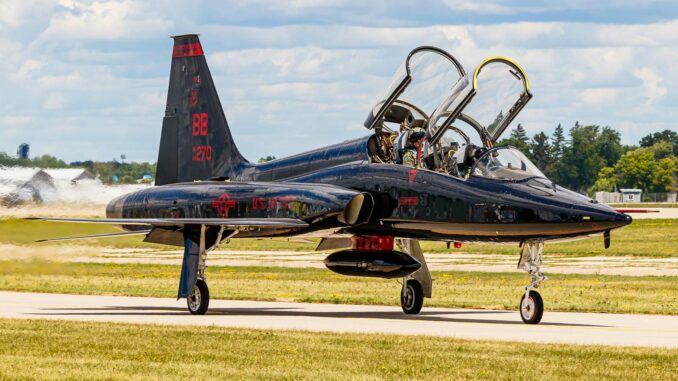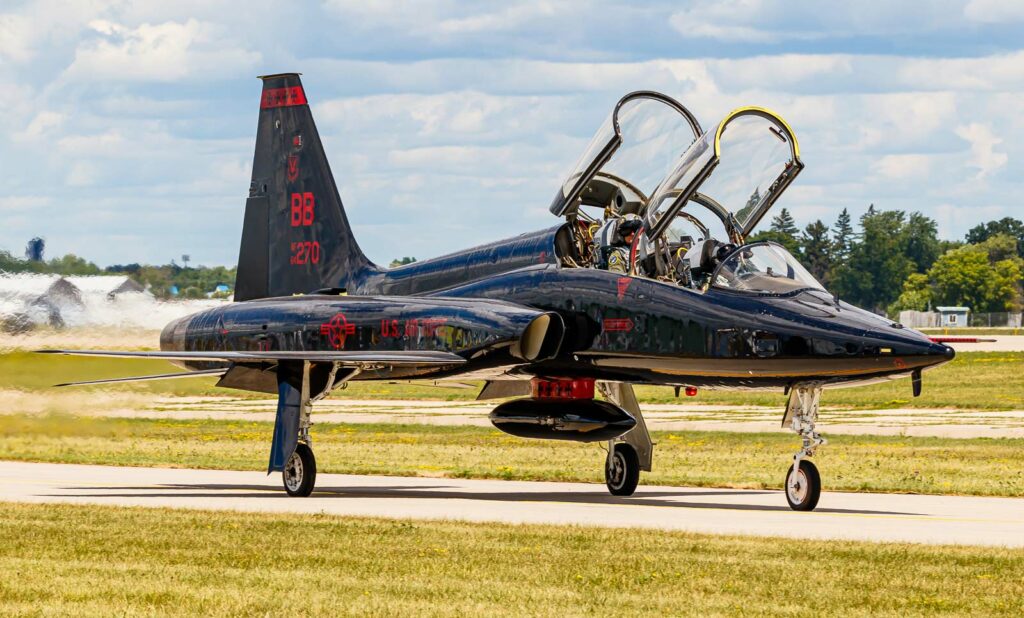
The US Air Force is facing a crucial pilot training dilemma, due to maintenance problems affecting its only intermediate trainer aircraft, the T-38 Talon, and a lack of high-tech flight simulators. The lack of high-tech simulators and maintenance problems with the T-38 Talon have slowed down USAF pilot training, leading to a shortage of qualified personnel and jeopardizing its readiness for future conflicts.
As conflicts erupt around the world, the US Air Force faces the daunting challenge of training its pilots in a context marked by maintenance problems affecting its only intermediate trainer aircraft, the T-38 Talon, and a critical shortage of high-tech flight simulators. In this article, we take a closer look at the current pilot training challenges facing the US Air Force, the impact of these problems on its readiness for future conflicts, and the steps being taken to remedy the situation.
Current challenges
US Air Force pilot training is currently hampered by two major problems: maintenance problems with the T-38 Talon, and the lack of high-tech flight simulators. The T-38 Talon is the only intermediate platform for teaching airmen to fly fighters and bombers. However, this fleet of trainer aircraft is facing engine maintenance backlogs that have slowed pilot training by at least six months. As a result, the USAF is expected to miss its pilot training target for FY 2023, with a shortfall of around 120 aviators against its annual goal of around 1,500 new aviators, marking the eighth consecutive year of missing this target.
The lack of high-tech flight simulators is another major challenge for the US Air Force. These simulators are essential for reproducing sophisticated scenarios and exploring unlimited combat possibilities. However, due to their scarcity, the USAF faces difficulties in properly assessing aircrew performance based solely on traditional sorties and aging simulators. The USAF’s ability to prepare for future conflicts is thus compromised.
Consequences of the lack of flight simulators
The lack of high-tech flight simulators has serious consequences for the US Air Force’s preparedness for future conflicts. USAF officials have pointed out that this shortcoming leaves the US Air Force woefully unprepared for future conflicts, as tensions between the USA and China continue to grow. Indeed, simulating the entire US Air Force in wartime is a daunting challenge, and pushing an aircraft like the F-35 to its limits during a training exercise can prove costly in the event of the loss of a pilot and an aircraft worth $80 million. In contrast, it is possible to push the limits during virtual practice, providing essential data on the capabilities of both aircraft and pilot.
The lack of high-tech flight simulators and maintenance problems with the T-38 Talon have slowed down USAF pilot training, leading to a shortage of qualified personnel. USAF officials are calling for improvements to prepare their pilots for next-generation warfare, as outlined in a research report published by the Rand Corp. a non-profit think tank focused on military issues. The report highlights the need for the Pentagon to fund sophisticated new flight simulators, sometimes referred to as “sims”.
US Air Force officials quoted in the report stress the crucial importance of flight simulators. One official states that there is an “unmet need for sims” and that, in an ideal world, the USAF would obtain more flight preparation data from simulators than from aircraft. The results we want to predict are not available from actual flights, the report states.
The lack of high-tech flight simulators has an impact on the USAF’s ability to train against potential threats, such as the rapidly strengthening Chinese People’s Liberation Army (PLA). The USAF is concerned that it will not be able to properly analyze aircrew performance based solely on traditional sorties and aging simulators. The Rand report states that the “relative scarcity of opportunities to train against such threats and the lack of tools to capture performance data mean that commanders must make subjective and incomplete assessments of their units’ capability in the most important operational scenarios.”
In addition, simulators for the B-1 Lancer, B-2 Spirit and B-52 Stratofortress bombers lack “fidelity”, meaning they are not a true representation of the aircraft or environment, according to the researchers. Similarly, US Air Force Special Operations Command simulators can’t keep pace due to the high frequency of modifications to the command’s aircraft, the report notes.

Solutions and initiatives
Faced with these challenges, the US Air Force is looking for solutions to improve its training and readiness for future conflicts. One important initiative is the Simulator Common Architecture Requirements and Standards program, or SCARS, launched by the US Air Force. In June, L3Harris was awarded an indefinite-delivery/indefinite-quantity contract worth up to $900 million to define, design, deliver, deploy and maintain a typical simulator architecture in the US Air Force training portfolio.
The SCARS initiative will implement a modular, open systems approach, as well as a set of common standards for US Air Force simulators, according to a Department of Defense announcement. The contract has a 10-year ordering period through June 2030.
Technological advances enable more detailed simulations of weapons and operational environments, allowing the US Air Force to transfer more training from the real world to the virtual world. High-tech simulators make it possible to model potential conflicts, change variables and conduct war games on a scale and scope never before possible.
The lack of high-tech flight simulators and maintenance problems with the T-38 Talon pose major challenges for the US Air Force in terms of pilot training and preparation for future conflicts. These problems are having a serious impact on the USAF’s ability to train effectively and assess the performance of its crews in the face of potential threats. However, initiatives such as the SCARS program show that the US Air Force is working to remedy these problems by investing in high-tech flight simulators and developing common standards for all its simulators. It is essential that the USAF resolves these issues to maintain its air superiority and readiness for future military challenges.
War Wings Daily is an independant magazine.